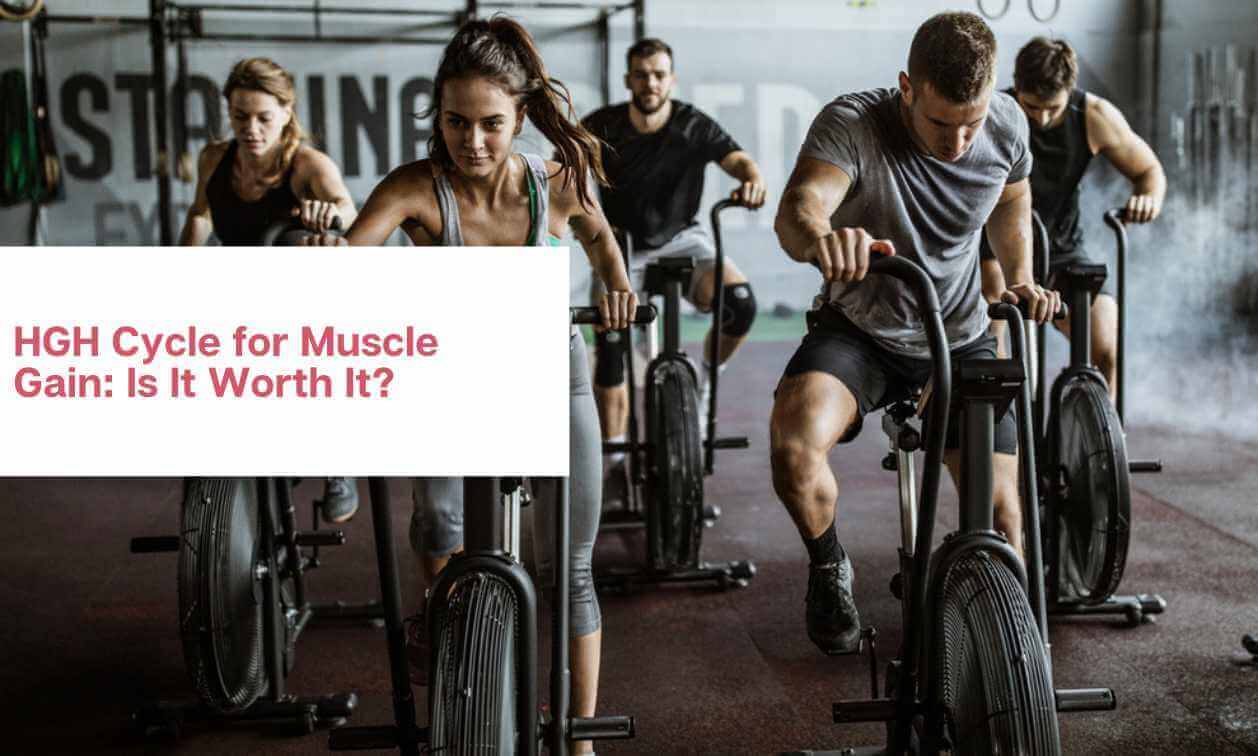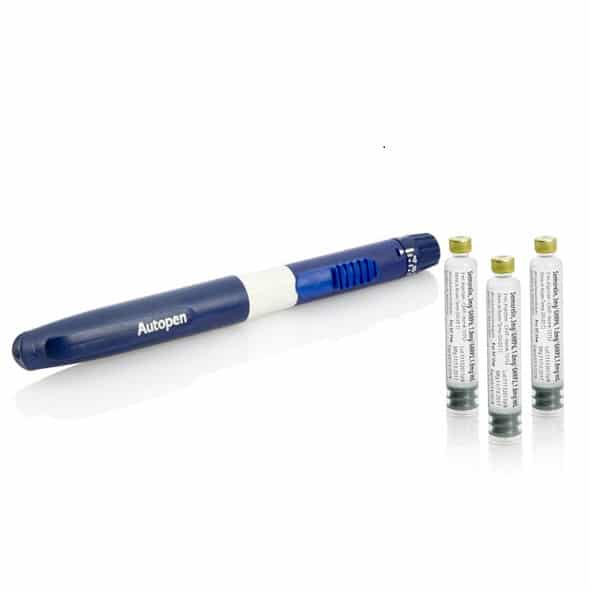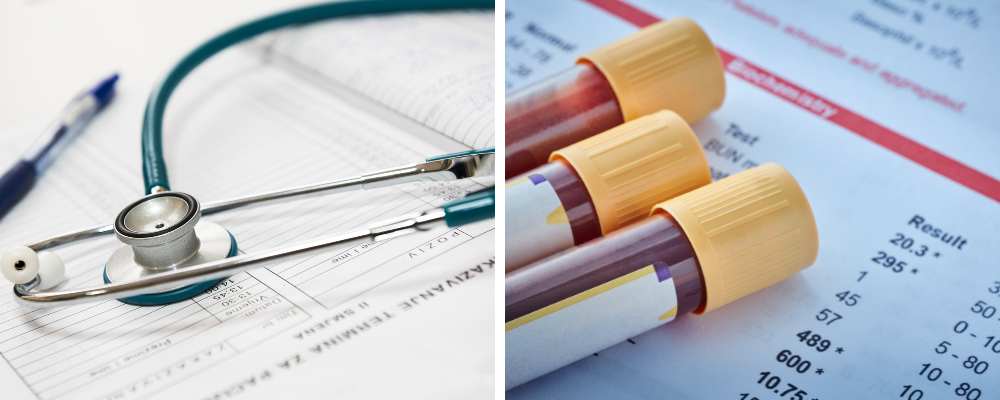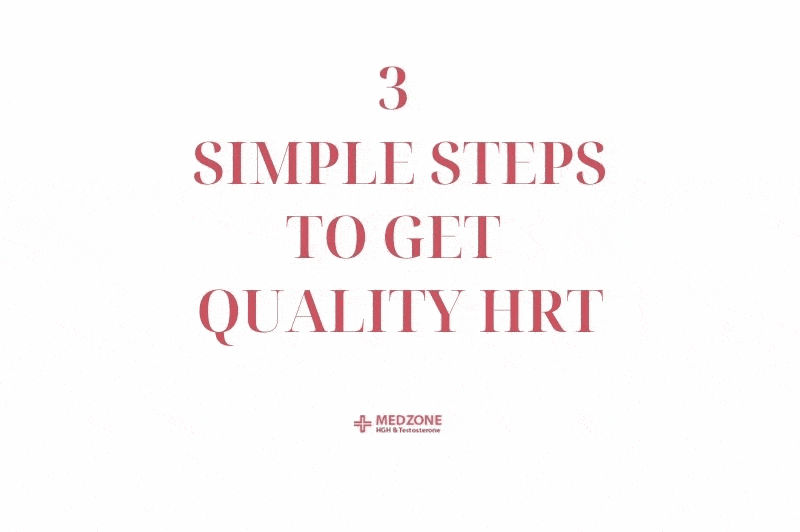
HGH Cycle for Muscle Gain: Is It Worth It?
Table of Contents
Synthetic human growth hormone (HGH) administered through hormone replacement therapy (HRT) is one of the most popular and effective supplements among both professional athletes and everyday people for facilitating muscle gain.
What is HGH?
Human growth hormone (HGH) is a hormone that is normally produced in sufficient quantities by the small pituitary gland located in the midbrain area. It is one of dozens of hormones in the human body, which function as chemical messengers responsible for regulating various physiological processes.
As the name suggests, HGH is closely involved in the synthesis and growth of new muscle tissue through multiple mechanisms, among other critical activities.
HGH, after it is released into the bloodstream by the pituitary gland, journeys south to rendezvous with another critical pro-growth (anabolic) hormone called insulin-like growth factor 1 (IGF-1). The pair of hormones then work together to perform various functions, including:
- Stimulating muscle development
- Strengthening bones
- Regulating metabolism (energy processing, use, and storage in fat cells)
- Optimizing body composition (fat distribution)
- Assisting in cardiovascular (heart) function
Contrary to popular belief, optimal levels of HGH are essential for optimal health across the lifespan, not just for children.
Synthetic HGH is a medication called somatropin, which has exensive clinical backing as a safe and effective tool to boost circulating HGH levels in patients diagnosed with a health condition called growth hormone deficiency (GHD).
Somatropin benefits for patients with growth hormone deficiencies, based on scientific research, include:
- More energy
- Restored sexual libido
- Fat loss, especially of the sort called visceral adipose tissue located around the midsection
- Sleeker, healthier, more youthful nails, skin, and hair
- Stronger, fortified bones
- Bigger, stronger muscles
What is the HGH cycle?
HGH cycles refer to periods of going on and off of HGH at regular intervals, with the incorrect idea being that HGH is most effective when the patient takes time off from therapy to allow for homeostasis to resume and to avoid dependency on the exogenous hormone.
The typical HGH cycle is several weeks on, followed by a shorter period of cessation, then starting the on cycle again.
Athletes utilizing HGH specifically for improved athletic performance and muscle gain often use HGH in cycles, as explained in the British Journal of Sports Medicine:
“The mean dose is about 4 IU/day in combination with other doping agents, such as anabolic steroids in power sports or EPO in endurance sport. GH is often taken in cycles of four to six weeks, as is the case for anabolic steroids in bodybuilding.”
Unlike other anabolic hormone supplementation like androgens (steroids), there is no medical need to cycle HGH for one simple reason: HGH supplementation does not suppress the natural function of the pituitary gland, so there is no drop-off in natural HGH secretion as a result of therapy.
Talk to your doctor about HGH cycling to learn more, and to find out how it might benefit you and why it’s not necessary for most patients.
Benefits & side effects of the HGH cycle
There may be some benefits that patients reap from cycling HGH, although in nearly all cases the better option for patients is simply to lower the dosage (under a doctor’s guidance).
The potential benefits of cycling off HGH temporarily might include:
- Restoring insulin sensitivity
- Alleviating HGH gut (aka “bodybuilder’s gut”). The Miami Herald explains HGH gut: “HGH gut is a condition characterized by a thickening of the muscles on the sides of the abdomen. It is likely caused by insulin and human growth hormone or HGH overuse. HGH gut is also referred to by several other names — palumboism, steroid or roid gut, bubble gut, insulin gut, muscle gut, bodybuilder belly, and so on.”
- Boost the muscle-building and fat-burning activities of HGH
The main reason to temporarily abstain from HGH supplementation is to counteract abnormally high doses, often as the result of illegal HGH use without the supervision of an experienced endocrinologist (hormone doctor).
The major concern regarding side effects associated with HGH cycling.
How much HGH should you take on a cycle?
Cycling HGH generally allows for higher dosages on a daily basis compared to patients that do not cycle HGH.
Let’s take a look at cycling vs permanent HGH dosing:
- HGH dosage for cycling: 3-6 mg
- HGH for permanent maintenance to manage GHD: 0.2 to 1.2 mg (0.6 to 3.6 IU) daily
The overriding goal of HRT with HGH should be to get and keep your levels in the optimal range, illustrated in the chart below:
| Normal HGH Levels in Adults | |
| Men | 0.4-10 ng/mL* |
| Women | 1-14 ng/mL |
Generally speaking, keeping HGH levels in the therapeutic window above is much easier when there is no HGH cycle. However, when it’s appropriate, elevating HGH levels temporarily beyond these normal HGH levels might not carry the same negative health effects that these levels might trigger if they are sustained over longer periods of time.
It’s absolutely essential that any HGH cycle is performed under the careful advisement and oversight of a doctor, as such high levels of HGH supplementation, even over relatively short timeframes, do carry significant risks including extreme water retention and dangerously low blood sugar (hypoglycemia) due to apoptosis of beta cells in the pancreas that causes drops in another important hormone, insulin.
Certain medical conditions call for specific dosing regimens on HGH cycles. For instance, HIV-positive patients are often prescribed HGH for up to twelve weeks at a dose of 3-6 mg/day. One study looking at HIV-positive individuals published in Annals of Internal Medicine who were administered 6 mg/day of exogenous HGH found impressive results in terms of weight gain and muscle development:
“Treatment with growth hormone resulted in a sustained and statistically significant increase in weight (mean increase +/- SD, 1.6 +/- 3.7 kg [P < 0.001]) and lean body mass (3.0 +/- 3.0 kg [P < 0.001]), accompanied by a decrease in body fat (-1.7 +/- 1.7 kg [P < 0.001]). In contrast, in patients receiving placebo, weight (increase, 0.1 +/- 3.1 kg), lean body mass (decrease, 0.1 +/- 2.0 kg), and body fat (decrease, 0.3 +/- 2.2 kg) did not change significantly from baseline.”
Again, such high levels of supplementation are not advisable for extended time periods, which necessitates the cycle.
How long should HGH cycles last?
The most common timeframe for HGH cycles is around 6 weeks, although some cycles can last up to 24 weeks (6 months). The desired timeframe depends on individual health goals, the underlying health condition being treated, and the extent of the growth hormone deficiency if one exists.
Unlike steroid (testosterone) use, there is no come-down or withdrawal effect associated with HGH cessation, so there is not a need to design a post-cycle therapy protocol, often abbreviated as PCT.
Men’s Journal explains PCT and why it’s useful for certain types of hormone therapies:
“Post cycle therapy (PCT) is a protocol that is started after completing a cycle of performance-enhancing drugs such as anabolic steroids and prohormones.
Compounds such as anabolic steroids and prohormones come with many benefits, with the most prominent effects being increased muscle growth and accelerated recovery.
But what most users don’t realize that they mess up your hormones pretty severely. Once you’re starting with using PEDs, they begin to suppress your body’s testosterone levels.”
The basic idea behind PCT is that it spurs the body to resume the natural production of hormones that may have been impaired during therapy.
Again, because natural HGH production during the administration of exogenous HGH (somatropin) is not impaired in any way, there is no reason that most patients require any form of PCT while coming off of an HGH cycle.
What results to expect from the HGH cycle?
Some HGH benefits begin to accrue more quickly than others, especially at the relatively high dosages typically administered on a cycle. Here’s what you can expect from an HGH cycle in terms of benefits:
- Increased self-confidence
- Optimized mental health (lifted depression/anxiety)
- Streamlined cognition (sharper short-term memory and focus)
- Higher-quality sleep via improved circadian rhythm
- Improved cardiovascular endurance
- Increased lean muscle mass. One study published in The Journal of Clinical Endocrinology and Metabolism looking at HGH administered on a 3-month (12-week) cycle found significant statistical gains in lean mass.

Is it safe to take the HGH cycle alongside a steroid cycle?
First of all, anabolic steroids such as testosterone cypionate are illegal in the United States if you aren’t prescribed the product by a licensed doctor. The Department of Justice explains:
“Yes, it is illegal to use steroids without a valid prescription or to distribute them. Steroids are Schedule III substances under the Controlled Substances Act. Schedule III drugs, which have a legitimate medical function, may lead to moderate to low physical dependence or high psychological dependence.”
So, with that caveat aside, let’s explore how synthetic HGH (somatropin) interacts with synthetic testosterone and the possible benefits weighed against the potential risks.
A study published in The Journal of Clinical Endocrinology and Metabolism found that the dual administration of HGH and testosterone produced profound benefits:
“Supplemental testosterone produced significant gains in total and appendicular lean mass, muscle strength, and aerobic endurance with significant reductions in whole-body and trunk fat. Outcomes appeared to be further enhanced with GH supplementation.”
Age-related declines in testosterone and HGH often occur simultaneously, so it might make sense to combine these two therapies together. Again, the critical precaution is that the potential risks of these therapies multiply when they are combined, so they should only be undertaken under the careful supervision of a hormone doctor.
Also, blood testing to measure both HGH and testosterone levels is necessary before embarking on this dual form of HRT.
What happens to the gains after coming off the HGH cycle?
The benefits of HGH replacement therapy will eventually wane upon cessation. For instance, one study published in The Journal of Clinical Endocrinology and Metabolism examined the fallout of quitting HGH therapy:
“After more than 3 yr of GH replacement therapy, a 4-month period of placebo treatment caused self-perceived deterioration in QoL and increased abdominal fat accumulation. Moreover, markers of systemic inflammation and lipid status deteriorated, whereas insulin sensitivity improved. Long-term continuous GH replacement is needed to maintain therapeutic effects of GH on QoL and cardiovascular risk factors.”
There may also be psychological ramifications associated with coming off of a cycle. Research published in the Oxford medical journal of clinical endocrinology explains:
“Psychological symptoms of GH withdrawal, reported in interviews at end-point by placebo-treated patients, included decreased energy, and increased tiredness, pain, irritability and depression.”
The resumption of therapy eliminates these physical and psychological impacts.
Conclusion
Unlike anabolic steroids, there is no need to cycle HGH for muscle gain as it does not suppress the function of the pituitary gland.
If you have GHD, discontinuing or interrupting HGH therapy abruptly without medical guidance will also make your symptoms return.
For these reasons and more, you should not cycle HGH, especially if you have GHD.
HGH for muscle gain FAQs
Let’s explore some of the most frequently asked questions (FAQs) regarding HGH for muscle gain.
Does HGH make your muscles bigger?
Yes. Research shows that HGH spurs muscle growth (see more references above for clinical data).
How much IU of HGH do I need to build muscle?
Doses starting at 2 IU per day, with a maximum of 10 IU per day, are optimal for building muscle, depending on each patient’s unique physiology and HGH deficiency severity. Always follow your doctor’s individual treatment plan for optimal results.
What is the amount of IU in 1 ml?
In diluted HGH (mixed with water), there is approximately 1 IU per 0.1 mL, so there would be 10 IUs per 1 mL. Always follow the instructions on the package to accurately calculate your dose.
How long does it take for HGH to build muscle?
Larger muscles and increased strength resulting from HGH therapy generally appear 3-4 months into therapy.


